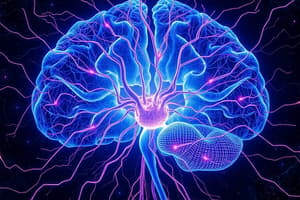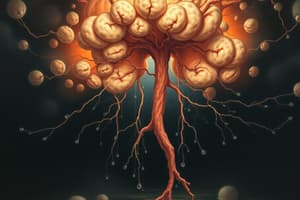Podcast
Questions and Answers
What are meninges?
What are meninges?
The three membranes (the dura mater, arachnoid, and pia mater) that line the skull and vertebral canal and enclose the brain and spinal cord.
What is the pia mater?
What is the pia mater?
Internal layer, directly covering the brain and spinal cord.
What is the dura mater?
What is the dura mater?
The outermost layer of the meninges which envelops the arachnoid mater and supports the dural sinuses.
What is the arachnoid mater?
What is the arachnoid mater?
What is cerebrospinal fluid?
What is cerebrospinal fluid?
What is the spinal cord?
What is the spinal cord?
What are spinal nerves?
What are spinal nerves?
What are tracts?
What are tracts?
What is the central canal?
What is the central canal?
What is an ascending tract?
What is an ascending tract?
What is a descending tract?
What is a descending tract?
What are spinal reflexes?
What are spinal reflexes?
What is the brain?
What is the brain?
What is the cerebrum?
What is the cerebrum?
What are cerebral hemispheres?
What are cerebral hemispheres?
What is the corpus callosum?
What is the corpus callosum?
What are gyri?
What are gyri?
What are sulci?
What are sulci?
What is a fissure?
What is a fissure?
What is the frontal lobe?
What is the frontal lobe?
What is the parietal lobe?
What is the parietal lobe?
Flashcards are hidden until you start studying
Study Notes
Meninges
- Consist of three membranes: dura mater, arachnoid mater, pia mater.
- Enclose and protect the brain and spinal cord.
Pia Mater
- Innermost layer of the meninges.
- Directly covers the brain and spinal cord.
Dura Mater
- Outermost layer of the meninges, termed "tough mother."
- Envelops the arachnoid mater and supports the dural sinuses, facilitating blood flow from the brain.
Arachnoid Mater
- Middle layer of the meninges, delicate in structure.
- Positioned between the dura mater and pia mater.
Cerebrospinal Fluid (CSF)
- Clear, colorless fluid filling the space between the arachnoid and pia mater.
- Provides protection and absorbs shock for the brain and spinal cord.
Spinal Cord
- A cylindrical bundle of nerve fibers enclosed in the spine.
- Connects body parts to the brain, forming the central nervous system.
Spinal Nerves
- Comprises 31 pairs of nerves originating from the spinal cord.
- Carries motor, sensory, and autonomic signals; organized into ascending and descending tracts.
Tracts
- Bundles of axons in the central nervous system, each carrying a specific type of information.
Central Canal
- A cerebrospinal fluid-filled channel running through the spinal cord.
- Connects with the brain's ventricular system and provides structural housing for the spinal cord.
Ascending Tract
- Nerve pathways transporting sensory information from the body to the brain.
Descending Tract
- Nerve pathways transmitting motor commands from the brain to lower motor neurons.
Spinal Reflexes
- Somatic reflexes integrated within the spinal cord, typically involving skeletal muscles.
- Clinical assessment of reflexes is crucial for evaluating nervous system integrity.
Brain
- Central control apparatus of the nervous system, composed of mass nerve tissue.
Cerebrum
- Primary area responsible for voluntary bodily functions.
- Represents the largest part of the brain.
Cerebral Hemispheres
- Consists of two mirror-image halves of the cerebrum, each contributing to the overall brain function.
- Characterized by an outer layer of grey matter.
Corpus Callosum
- A large bundle of neural fibers connecting the brain's two hemispheres.
- Facilitates interhemispheric communication, situated deep in the central groove.
Gyri and Sulci
- Gyri refer to elevated ridges or "wrinkles" of the brain.
- Sulci are shallow grooves separating gyri.
Fissure
- A long narrow slit or groove that divides an organ into lobes.
Frontal Lobe
- The largest lobe, located in the upper forward part of each hemisphere.
- Involved in movement, abstract thinking, planning, memory, judgment, and personality attributes.
Parietal Lobe
- A significant section of the cerebrum, functions related to sensory perception and integration.
Studying That Suits You
Use AI to generate personalized quizzes and flashcards to suit your learning preferences.




